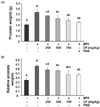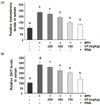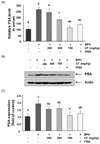Abstract
BACKGROUND/OBJECTIVES
MATERIALS/METHODS
RESULTS
Figures and Tables
 | Fig. 1Flow diagram of the experimental procedure: a rat model of BPH.Control, corn oil-injected and PBS-treated rats; BHP, TP (3 mg/kg)- and PBS-treated rats; CF-250, TP (3 mg/kg)- and CF (250 mg/kg)-treated rats; CF-500, TP (3 mg/kg)- and CF (500 mg/kg)-treated rats; CF-750, TP (3 mg/kg)- and CF (750 mg/kg)-treated rats; FINA, TP (3 mg/kg)- and finasteride (5 mg/kg)-treated rats. BPH, benign prostatic hyperplasia; CF, Corni Fructus water extract; TP, testosterone propionate; FINA, finasteride.
|
 | Fig. 2Effects of CF administration on prostate weights in TP-induced BPH rats.Changes in the prostate total weight (A) and relative prostate weight ratio (B) were assessed for the control, BPH-induced, CF-, and FINA (finasteride)-treated groups. The data shown represent the mean ± SEM of six rats per group (P < 0.05). BPH, benign prostatic hyperplasia; CF, Corni Fructus water extract; FINA, finasteride.
|
 | Fig. 3Effects of CF administration on the histological changes in the prostate tissues of TP-induced BPH rats.Representative photomicrographs of the H&E-stained prostate tissues are presented (magnification, 200X). Control, corn oil-injected and PBS-treated rats; BHP, TP (3 mg/kg)- and PBS-treated rats; CF-250, TP (3 mg/kg)- and CF (250 mg/kg)-treated rats; CF-500, TP (3 mg/kg)- and CF (500 mg/kg)-treated rats; CF-750, TP (3 mg/kg)- and CF (750 mg/kg)-treated rats; FINA, TP (3 mg/kg)- and finasteride (5 mg/kg)-treated rats. BPH, benign prostatic hyperplasia; CF, Corni Fructus water extract; FINA, finasteride.
|
 | Fig. 4Effects of CF administration on testosterone and DHT in serum of TP-induced BPH rats.The serum concentrations of testosterone (A) and DHT (B) were examined by ELISA. The data shown represent the mean ± SEM of six rats per group (P < 0.05). BPH, benign prostatic hyperplasia; CF, Corni Fructus water extract; FINA, finasteride; DHT, dihydrotestosterone.
|
 | Fig. 5Effects of CF administration on 5α-reductase type 2 in TP-induced BPH rats.(A) The serum concentrations of 5α-reductase type 2 were examined by ELISA. The data shown represent the mean ± SEM of six rats per group (P < 0.05). (B) Representative photomicrographs of prostate tissues immunostained with an anti-5α-reductase type 2 are presented (magnification, 200X). Control, corn oil-injected and PBS-treated rats; BHP, TP (3 mg/kg)- and PBS-treated rats; CF-250, TP (3 mg/kg)- and CF (250 mg/kg)-treated rats; CF-500, TP (3 mg/kg)- and CF (500 mg/kg)-treated rats; CF-750, TP (3 mg/kg)- and CF (750 mg/kg)-treated rats; FINA, TP (3 mg/kg)- and finasteride (5 mg/kg)-treated rats. (C and D) The expression levels of 5α-reductase type 2 in prostate tissues were determined by Western blotting. The experiment was repeated three times among different experimental groups, and all the results were similar (C). Actin was used as an internal control. Values are mean ± SD of data from three separate experiments (P < 0.05) (D). BPH, benign prostatic hyperplasia; CF, Corni Fructus water extract; FINA, finasteride.
|
 | Fig. 6Effects of CF administration on AR expression in TP-induced BPH rats.(A) Representative photomicrographs of prostate tissues immunostained with an anti-AR are presented (magnification, 200X). Control, corn oil-injected and PBS-treated rats; BHP, TP (3 mg/kg)- and PBS-treated rats; CF-250, TP (3 mg/kg)- and CF (250 mg/kg)-treated rats; CF-500, TP (3 mg/kg)- and CF (500 mg/kg)-treated rats; CF-750, TP (3 mg/kg)- and CF (750 mg/kg)-treated rats; FINA, TP (3 mg/kg)- and finasteride (5 mg/kg)-treated rats. (B and C) The expression levels of AR, AR co-activators (ARA70 and SRC1) and PCNA were determined by Western blotting. The experiment was repeated three times among different experimental groups, and all the results were similar (B). Actin was used as an internal control. Values are mean ± SD of data from three separate experiments (P < 0.05) (C). BPH, benign prostatic hyperplasia; CF, Corni Fructus water extract; FINA, finasteride; DHT, dihydrotestosterone; AR, androgen receptor; ARA70, AR-associated protein 70; SRC1, steroid receptor coactivator-1; PCNA, proliferating cell nuclear antigen.
|
 | Fig. 7Effects of CF administration on PSA in TP-induced BPH rats.(A) The serum concentrations of PSA were examined by ELISA. The data shown represent the mean ± SEM of six rats per group. The ***P < 0.001 vs. Control group; ##P < 0.005, ###P < 0.001 vs. BPH group. (B and C) The expression levels of PSA in prostate tissues were determined by Western blotting. The experiment was repeated three times among different experimental groups, and all the results were similar. Actin was used as an internal control. Values are mean ± SD of data from three separate experiments (P < 0.05) (C). BPH, benign prostatic hyperplasia; CF, Corni Fructus water extract; FINA, finasteride; PSA, prostate-specific antigen.
|
 | Fig. 8A suggested schematic model for the inhibitory effect of CF on pathogenesis of BPH.BPH, benign prostatic hyperplasia; CF, Corni Fructus water extract; DHT, dihydrotestosterone; AR, androgen receptor; ARA70, AR-associated protein 70; SRC1, steroid receptor coactivator-1;PAS, prostate-specific antigen.
|
Table 1
Effects of CF treatment on the body weights of experimental rats

Values are represented as the mean ± SEM of six rats.
Control, corn oil-injected and PBS-treated rats; BHP, TP (3 mg/kg)- and PBS-treated rats; CF-250, TP (3 mg/kg)- and CF (250 mg/kg)-treated rats; CF-500, TP (3 mg/kg)- and CF (500 mg/kg)-treated rats; CF-750, TP (3 mg/kg)- and CF (750 mg/kg)-treated rats; FINA, TP (3 mg/kg)- and finasteride (5 mg/kg)-treated rats. CF, Corni Fructus water extract; BHP, benign prostatic hyperplasia; TP, testosterone propionate. FINA, finasteride
Table 2
Effects of CF treatment on the relative organ weights of BHP rats

Values are represented as the mean ± SEM of six rats.
Control, corn oil-injected and PBS-treated rats; BHP, TP (3 mg/kg)- and PBS-treated rats; CF-250, TP (3 mg/kg)- and CF (250 mg/kg)-treated rats; CF-500, TP (3 mg/kg)- and CF (500 mg/kg)-treated rats; CF-750, TP (3 mg/kg)- and CF (750 mg/kg)-treated rats; FINA, TP (3 mg/kg)- and finasteride (5 mg/kg)-treated rats. CF, Corni Fructus water extract; BHP, benign prostatic hyperplasia; TP, testosterone propionate. FINA, finasteride.
Table 3
Effects of CF treatment on the serum biochemical parameters for the liver and kidney functions of BHP rats

Values are represented as the mean ± SEM of six rats.
Control, corn oil-injected and PBS-treated rats; BHP, TP (3 mg/kg)- and PBS-treated rats; CF-250, TP (3 mg/kg)- and CF (250 mg/kg)-treated rats; CF-500, TP (3 mg/kg)- and CF (500 mg/kg)-treated rats; CF-750, TP (3 mg/kg)- and CF (750 mg/kg)-treated rats; FINA, TP (3 mg/kg)- and finasteride (5 mg/kg)-treated rats. CF, Corni Fructus water extract; BHP, benign prostatic hyperplasia; TP, testosterone propionate. FINA, finasteride; ALT, alanine aminotransferase; AST, aspartate aminotransferase, BUN, blood urea nitrogen
Notes
This work was supported by “Food Functionality Evaluation program (G0090200-09)” under the Ministry of Agriculture, Food and Rural Affairs and partly Korea Food Research Institute and Basic Science Research Program through the National Research Foundation of Korea (NRF) grant funded by the Korea government (2018R1A2B2005705).




 PDF
PDF ePub
ePub Citation
Citation Print
Print



 XML Download
XML Download